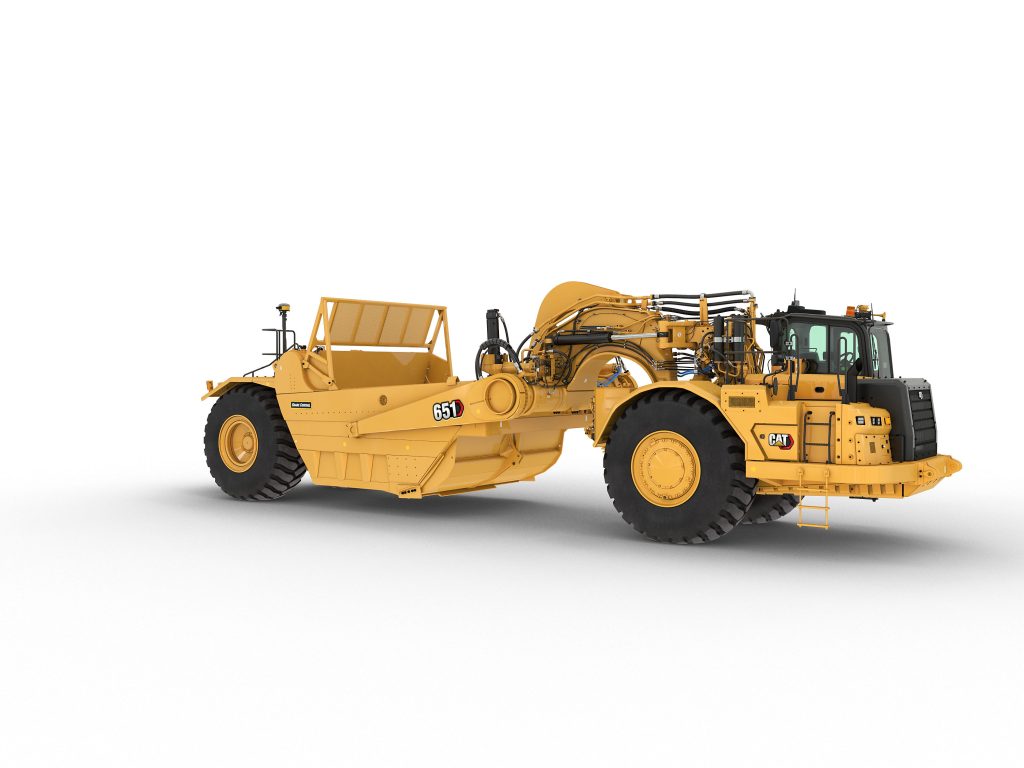
Products & Equipment
Heavy Equipment
Caterpillar relaunches its 651 wheel tractor scraper
February 14, 2022 By Rock to Road staff
 The new single engine Cat® 651 Wheel Tractor Scraper (WTS). (Image: Caterpillar)
The new single engine Cat® 651 Wheel Tractor Scraper (WTS). (Image: Caterpillar) Caterpillar has reintroduced its single engine Cat 651 wheel tractor scraper with upgrades to controls, hydraulics and the powertrain.
With a 33.6 cubic metre heaped capacity and a rated load of 46.4 tonnes, the new WTS shares the same bowl design and many components as the 657, allowing companies with mixed fleets to stock fewer repair parts and lower owning costs.
Caterpillar adds APECS
The scraper’s new Advanced Productivity Electronic Control System (APECS) fully integrates the transmission and engine drivetrain to provide smooth and responsive shifts, allowing the 651 to move more material faster. As well, its electronic clutch pressure control features advance shift control logic for smoother speed and directional shifts, while part throttle shifting controls transmission shifts for smoother shifting between gears.
To prevent loss of momentum during shifts, the shift torque management system carries higher torque through shift points.
Its single engine design features the Cat C18 engine powering the tractor with 629 hp and meets EPA Tier 4 Final emission standards. The design gives the Caterpillar 651 WTS the ability to work with a Caterpillar D10 or D11 push dozer for ultra-fast load times, even when working in abrasive or rocky conditions. With its 8-speed transmission reaching a top speed of 56.1 km per hour, the WTS delivers fast cycle times to improve productivity across a range of applications from heavy civil construction to quarrying to mining.
Production efficiency
Auto-stall, which is new for the 651, assists in warming up the transmission oil faster when working in colder ambient temperatures, so the machine is quickly ready for work. Configured with sequence assist, the new payload estimator option uses bowl lift cylinder pressure to accurately calculate machine payload to within +/- 5 per cent of actual scaled weight, optimizing payload and jobsite efficiency. Using the bowl lift cylinder, the reliable payload estimator system requires no recalibration or operator interface.
RELATED: Caterpillar to debut new compact pavers and screeds
The scraper’s new ground speed control allows the operator to set the desired top speed, and the machine will find the gear that works best for the engine and transmission to lower engine load factor and fuel burn compared to top gear selection. When operating on a decline, the 651 detects a machine overspeed situation and automatically engages the compression brakes with no operator input. Hydraulic wet disc brakes replace air actuated brakes from the previous model to improve performance and serviceability.
A familiar cab
Boasting the same, larger cab as the 657, the new 651 improves operator comfort and delivers easier ingress and egress. Relocation of the heating, ventilation and air conditioning (HVAC) system to below the cab plus steering column and pedal repositioning help to improve visibility. The new comfort seat rotates up to 30 degrees to the right for loading and offers an extra 51 mm of fore/aft movement to reduce operating fatigue. The seat’s adjustable armrest aligns with the implement control level with T-handle design for more comfortable operation.
The scraper’s new high-pressure steering system requires significantly less steering effort, reducing fatigue and improving productivity further into the work cycle. Improvements to the hydraulics include an electrohydraulic implement system for improved multifunction capability and a short throw for the T-handle implement control. Offering a smoother ride, Cat advanced ride management eliminates end-stroke events of the seat suspension cylinder.
As well, three camera locations for the optional Work Area Vision System (WAVS) show the cutting edge, right side and rear of the machine on a 178-mm in-cab colour display to improve visibility and job site safety. Available sequence assist reduces up to 14 individual operator commands per cycle with a single button for improved cycle consistency, less repetitive motions for the operator and reduced fatigue.
Print this page